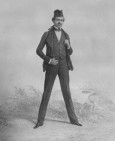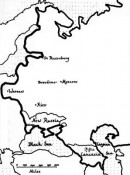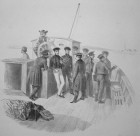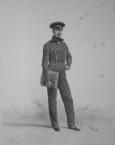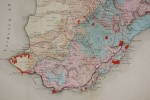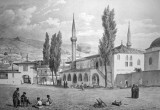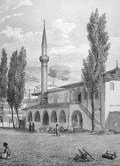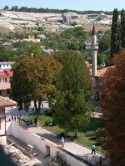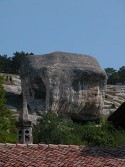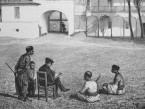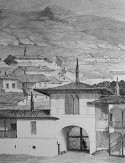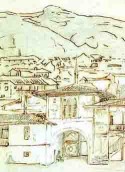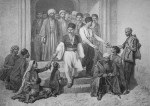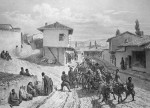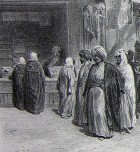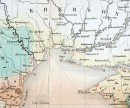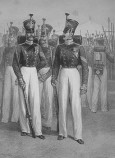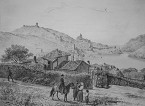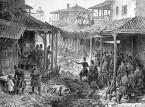The browser will either open the file, download it, or display a dialog.
Still feeling the sting of Napoleon's defeat in Moscow decades earlier, French writer Paul de la Garenne, describing a dramatic daguerreotype of the Kremlin in winter by Noël Paymal Lerebours, wrote in 1841:
Moscow reveals herself to us in her sparkling winter dress. It clothes everything, as though with a flood of snow—this snow in which we buried our treasures, our spoils, twelve hundred canons, and three thousand men—right down to the flag that we expected thus to strip from our enemy.[1]
Years later, Alexandre Dumas père would view the same cityscape through the same painful prism. At the outset of an ambitious voyage that would take him to the far Asiatic fringe of the Russian Empire, he expresses his yearning to track, in and among Moscow's monuments, traces of the historic conflagration that sealed the fate of Napoleon's troops:
We'll climb the citadel of the tsars—to see not only its palace domes, gilded or painted in green, the clock towers of its churches, its neighborhoods, . . . but also the trace of this terrible fire that devoured a city of three hundred fifty thousand inhabitants and froze an army of a thousand men.[2]
The passages remind us of the status of buildings—and their representations—as texts that can be read for clues about their makers and users. A view of the snow-covered Kremlin calls up memories of military defeat; to survey the picturesque protuberances of its towers and domes is to recapture an awful event that unfolded there.[3] The passages should also alert us to the interpretive difficulties of such readings. First, Adrian's Forty's caution that architecture is not "a reliable medium of ideas," applies equally well to cultural artifacts and their images in general: "they may indeed immortalize and glorify something, but what people understand that something to be is all too likely to change."[4] Second, this semantic shiftiness, which Forty describes in temporal terms (meanings change over time)[5] is compounded when meanings attempt to cross cultural, political, and geographical divides. When we seek to read alien cultures through their artifacts, and through the added mediation of representation, we enter a space of translation, with all of the traps and gaps that this process implies.[6]
The following analysis of a lavish lithographic album documenting a French expedition to the Crimea in 1837 will seek to untangle the multiple strands of signification of one particularly intriguing case of cross-cultural representation in the 19th century. Close attention to the multiple voices that speak through Anatole Demidov's four-volume Voyage dans la Russie méridionale (1840–42), and to the complex meanings its Album of illustrations may have produced in the midst of nineteenth-century imperialist expansion, will expose contradictory messages about empire and "colony," about civilized centers and exotic peripheries.[7] In the process, this reading will inflect received models of "orientalist" representation for subtler application to extra-European contexts and for more meaningful illumination of the many hybrid cases where self and other intertwine.
France and Russia in the 19th Century
When Dumas and La Garenne attempt to translate for the home audience the meanings of monuments they encounter in Russia at mid-century, they do so through the mediating screens of their own subjectivities—products of personal backgrounds and agendas, commercial imperatives, and historical and contemporary geopolitics. To ignore interpretive slippages that result from this process of translation is to be taken in by the complex biases that inform cross-cultural accounts. Dennis Porter's question, "is there a place of truth, in the representation of one culture by another?" points up the semantic fragility of other-observation in general.[8] But in setting aside unstable "truth" as a goal of analysis, we needn't, correspondingly, bemoan these translated messages as un"truths." On the contrary, they are rich and revelatory, and tell their own stories—about the observers as well as the observed.
Narrative sub-texts can lodge quite close to the surface—when the French Marquis de Custine describes the Kremlin fortress as the very image of state-sponsored terror ("In vain is each turret distinguished by its peculiar character and its particular use; all have the same signification—terror armed"),[9] he betrays his own reactionary position within contemporary French political debates.[10] But in many cases, authorial agendas are less monolithic and readily recognizable. Demidov's Voyage dans la Russie is a case in point. One of two spectacular Russian publications Demidov sponsored,[11] the Voyage fits into a longer French discourse on Russia, spanning a century that saw each country by turns at the peak of its power, and suffering devastating defeat. The story of Franco-Russian relations in the nineteenth century is one of two empires, both engaged in protracted expansionist struggles with southern, non-Christian powers (in the case of Russia, the then sprawling but ailing Ottoman Empire). As France was invested in maintaining its perceived cultural superiority while nervously monitoring Russia's redoubtable military might, the latter strove vigorously to prove itself in the inner circle of "civilized" European nations, while keeping at bay the liberalizing influences such contact introduced.
Demidov's trip was undertaken in the wake of Napoleon's 1812 defeat in Russia and thus at a high point of Russian power in Europe. Western Europe witnessed nervously the violent suppression by Emperor Nicholas I of the anti-monarchical Decembrist uprising in 1825 and the Polish revolt in 1830–31. His collisions with the Ottoman Empire in the south to gain control of Black Sea coast would culminate in the Crimean War soon after the Demidov voyage—a war provoked by Britain and France's mounting concerns about Russian domination in southeast Europe. As French travel writer George Depping wrote in 1835: "Russian might has mounted to such a point as to worry the other powers. There has never existed in Europe an empire of the extent of the Russian empire, which extends to Eastern Europe and the entire north of Asia."[12]
And just as political relations between the French and Russian states vacillated dramatically between ally and foe during this period, so the literature of French representation of Russia—through visual and textual description of monuments, landscapes, and ethnographic typologies—runs the gamut from Custine's withering critique of 1839, to architect Viollet-le-Duc's analytical appreciation, in his 1877 L'art russe, of the expressive rationality of Muscovite onion dome structure.[13] To read these texts and images is to chart these turbulent politics—if this reading takes into account the complex sponsorship of each particular project and the representational strategies deployed by its makers. For this is not an exclusively uni-directional literature, wherein one culture lays claim to another through representation, by fixing its identity.[14] Nor is it in every instance typical traveler imagery, capturing its subjects on the fly, without benefit of "local knowledge."[15] Rather, a number of these projects are implicit or explicit collaborations, in which the agendas of viewer and viewed are thoroughly intertwined. These offer the possibility of multivocal representation, through which the object of observation might be seen to "write back," as James Clifford has aptly put it.[16] Viollet-le-Duc, for example, was supplied with raw material by Russian sponsors eager to promote abroad a particular vision of Russian identity, and his drafts, which shaped that material within the contours of his own theories of national expression, were vetted before publication by those same sponsors.[17] Commemorative albums documenting the coronations of the nineteenth century tsars likewise reflect hybrid sponsorship and voice: penned and illustrated by westerners channeling the agendas of the crown while betraying their own outsider perspectives.[18] These books were aimed simultaneously at internal Russian and external European audiences.
Demidov's Voyage dans la Russie méridionale: Sponsors and Authors
The sumptuous publications underwritten by Anatole Demidov are similarly hybrid in conception, execution, and reception. Demidov hired a team of French artists and scientists to represent his homeland to the French audience—but with the barely veiled simultaneous intent of flattering his own disenchanted (with him) tsar.[19] Anatolii Nikolaevich Demidov, Prince of San Donato (1812–70) was born in Moscow into a family whose fortune had been made several generations earlier in the mining of iron, copper, and various other metals and minerals. Anatole's great grandfather had been an iron forger in the service of Peter the Great (1682–1725), who granted to him mineral holdings and a disused ironworks factory.[20] The family prospered; the eighteenth-century Demidovs constructed over fifty iron and copper enterprises and "propelled Russia to the forefront of the world iron industry" by meeting over forty percent of the state's iron demand.[21] By the middle of the nineteenth century, an estimated 45,000 serfs were employed in the Demidov metalworks.[22] Despite his Russian birth and business interests and his status as a subject of the tsar, Demidov was more at home in Paris and San Donato, near Florence, where his art-collecting father commissioned a villa for the family's burgeoning collection. Anatole would follow in his father's footsteps—acquiring art, adding on to the villa, and donating to local charities in princely fashion (the title "Prince of San Donato" was bestowed in the wake of a strategic marriage to Mathilde Bonaparte, niece of Napoleon I; his inherited title in Russia was count).[23] The brash confidence of this wealthy young man of two worlds is captured in the portrait produced for Voyage dans la Russie méridionale by fellow-traveler and expedition artist Denis-Auguste Raffet (fig. 1).
The scope and quality of Anatole's art collecting enterprise was prodigious. Haskell refers to him as one of the two "most lavish collectors" of Second Empire France;[24] his interests ranged from Old Master paintings of the Dutch school to the contemporary French scene. Demidov supported the young Delacroix, who exhibited a portrait of Demidov in the Salon of 1833, and bought works by Delaroche, Descamps, and Vernet, among others. Records of the sale of the San Donato collections reveal that his interest in Russian art was marginal. He did, however, patronize the prominent Karl Briullov, from whom he commissioned a portrait and "The Last Days of Pompeii," which would come to be regarded as one of the major works of nineteenth century Russian painting.[25]
These brief details of biography bear directly upon the hybridity of voice that characterizes the Demidov volumes. Given his cosmopolitan upbringing, spent largely in Europe with only sporadic stays in Russia, Demidov was a man between two cultures; to many he appeared more European than Russian (he reportedly "spoke most European languages except Russian")[26] and was described by one contemporary as "hardly Russian."[27] And yet Emperor Nicholas I, who acceded to the Russian throne in 1825, kept him on a relatively short tether. Demidov served the Russian state as ambassador in Paris, Rome and Vienna, and was called back to the homeland periodically, apparently by a tsar who took a dim view of his high society posturing and at times extravagant behavior. Indeed, his tenuous relationship with the Russian crown has been offered by scholars as a key factor motivating Demidov's decision to finance, and dedicate to Emperor Nicholas, an enormously expensive scientific expedition to southern Russia and the Crimea in 1837.[28]
The Mission: Prospecting in the New Russia
While it was the architectural and ethnographic imagery of Raffet's Album that assured the 1837 expedition some mention in posterity,[29] these views, sketched in situ and polished later in a Paris studio (fig. 2),[30] were a by-product, not the central purpose, of the journey. As Demidov describes it, the principal objective of the trip was to conduct a mineralogical and geological survey of the recently annexed territories of the "New Russia" (fig. 3).[31] The fruit of fifty years of imperial expansion initiated by Empress Catherine,[32] the so-called Novaia Rossiia (now southern Ukraine) stretched from the northwest coast of the Black Sea, where the new port city of Odessa was quickly established, and extended inland and eastward to the Crimean peninsula, which would see war with the major Western European powers a few decades after the Demidov voyage (fig. 4). The New Russia combined agriculturally promising steppe land, largely unsettled and uncultivated but quickly populated by colonists from diverse corners of Russia, and established communities, whose now subjugated native populations included Crimean Tatars and Cossacks. The area was of great strategic and commercial value, providing Russia with a southern port in close proximity (through the Bosporus) to the Mediterranean, and with a physical buffer zone between the Russian metropole and hostile southern neighbors.[33] Also, not inconsequentially, it represented a religious reconquest of lands that long ago fell within the borders of the Byzantine Empire—this is made clear at Demidov's first mention of Catherine's "belle conquête" of the region: imagine the Black Sea, he writes, "surprised to find herself washing over a pacified and Christian territory."[34]
It was the economic potential that most interested Demidov and the Empire he served, which had wrested these territories from the Ottoman Turks (who had won them from the Tatar Khans in the fifteenth century). His hope for the region, which is cast in patriotic terms, centered on the possibility of finding new sources of coal, at the time rapidly replacing wood as a fuel of choice and increasingly critical to large-scale manufacturing success.[35] "Will southern Russia have an industry of its own?" Demidov asks in the opening pages of the travel account volume of the Voyage. "If nature has deprived these vast southern solitudes of the fir and the oak, perhaps the soil will prove less grudging, and to a nascent industry offer up coal—this new soul of the material world, which can now make the fortune of a people more quickly than gold."[36] The purpose of the expedition is elaborated in the frontispiece to the accompanying Album:
In the spring of 1837, a numerous company of travelers—lovers of science but even more so of travel—arranged to meet in the southern plains of Russia. The first group set off from St. Petersburg; led by M. Paul Kolounoff they traversed our immense empire, dragging behind them an enormous load of equipment. Their mission was to explore, with the boring drill, the coal seams recently discovered in the land of the Don Cossacks.[37]
The group of scientists led by Kolounoff was joined by a second contingent: French engineers Léon Lalanne and Henri Malinvaud traveled directly eastward to the study site by way of the then Austrian lands of Galicia (straddling today's Poland and Ukraine). The scientists' site was not haphazardly chosen; the Demidov family had "extensive and largely undeveloped possessions"[38] in the valley of the Donets River, a tributary of the Don River (which flows through what is now Ukraine) that ultimately joins the Don before it meets the Azov Sea (northeast of the Crimean peninsula and connected by narrow straits to the Black Sea). The Russian interest in developing its resources in this relatively barren and climatically harsh region was matched by France's wish to keep a keen eye on potential competitors to its own developing industry. Like Demidov himself, Frédéric Le Play, the French leader of his mineralogical team, was serving two masters.[39]
Picturing the New Russia: Raffet's Vision
A third band of travelers, "whose mission embraced the arts, natural history, and general observations," boarded the steamship François Ier in Vienna, and set off on a more leisurely journey down the Danube toward the Black Sea.[40] Demidov himself led this group (fig. 5), which would experience, in their slower travels through more varied territories, the combination of dramatic scenery, picturesque townscapes and diverse populations pictured by team artist Raffet (fig. 6). Like engineer Le Play, Raffet's participation in the 1837 expedition would result in many years of employment in the Demidov empire; he would accompany the Prince on subsequent journeys to Spain and Holland, and serve as his personal collection consultant, advising Demidov on acquisitions throughout his life and residing for long periods in San Donato, through the benefaction of his patron.[41]
A master draftsman and lithographer who also was trained in painting, Raffet (fig. 7) was educated in Paris in the studios of the popular graphic artist Nicolas Toussaint Charlet (whose reputation he would eclipse, clouding the accomplishments of both[42]) and at the Ecole des Beaux Arts, where he was taught by Baron Antoine-Jean Gros.[43] Like Charlet, he developed a facility for military imagery, and made his reputation as a chronicler of the French Revolution and the Napoleonic wars, already a subject of nostalgic fascination in the turbulent years of the July Monarchy.[44] It was in no small measure through Raffet's stirring and romanticizing images of Napoleon Bonaparte and his legions that the public of his generation, and those to follow, came to understand this epic and ultimately ill-fated episode of the nation's not distant past.[45] His interest in the man in uniform and the field of battle was not limited to the French experience; as discussed below, Raffet's Russian views and his images of the contemporary French war in Algeria reveal the thoroughgoing fascination of this "Giotto du soldat" with all things military, from ceremony to combat.[46] Raffet's reputation preceded him in Russia, and paved the way for unprecedented access to sites and scenes of interest. While Demidov himself was on uncertain terms with the tsar, the talents of his pomp-loving artist were clearly appreciated by a Russian ruler keen on burnishing his European reputation. Demidov relates an episode at the military colony of Voznesensk, where Nicholas was participating in an annual review of troops, in which the Emperor called out to Raffet by name, invited him for a personal audience with himself and the Empress, and assigned to him a high-level officer whose job it was to provide Raffet with access to anything he wished to see.[47]
As author of the stunning imagery of the Voyage dans la Russie méridionale, Raffet's own motivations and predilections must be folded in with those of Demidov, as these would have lent their own shading to Demidov's overall "picture" of southern Russia. Interestingly, in this regard, Raffet foregrounds his own status as foreign observer, actually placing himself within various scenes in a manner that clearly distinguishes him as an outsider or signaling his presence at the scene by other means. The device highlights the authorial subtleties of the project: what voices speak through these images and how do they inflect the meanings they produce?
Who is observing whom? The Khan Palace of Bakhchisarai
Especially revealing in this light are a handful of images documenting the group's several-day stay in the Crimean town of Bakhchisarai (palace of gardens), former capital of the Tatar khanate that ruled in the region before the Ottoman conquests of the late fifteenth century (fig. 8). As will be shown, Raffet's visually compelling views of this fabled point of architectural intersection between East and West encapsulate the interpretive complexities of the overall encounter.
The town's Tatar origins go back to the days of the Genghis Khan and the so-called Golden Horde, originating in Mongolia, who dominated Russia from 1237 until the 1500s. The travelers' first view of this legendary locale, as narrated in Demidov's text, is a classic example of what Mary Louise Pratt terms, in the context of the literature of imperial conquest, a "promontory description."[48] Coming upon the seat of former Tatar glory, Demidov writes:
Another hour passes across this deceptive desert, when finally barkings make themselves heard, a few lights burn in a sort of chasm at our feet: only then can we distinguish, amid the mist, the pointed tops of white minarets.[49]
In Pratt's framework, the imperial (and typically western) observer lays psychological claim to his colonial "other" through a physically dominant vantage point (looking down upon the alien land or townscape—in this case, a "chasm at our feet") and by surprise—by the sudden "discovery" of lands that seem not to have existed until the western eye see them. Deborah Cherry sees the same dynamics at play in contemporary French images of the Algerian landscape, referencing Spivak's conception of "worlding," whereby alien "earth" is turned into understandable "world" through description and representation in western terms—all for the not benign process of controlling colonial acquisitions."[50] The "worlding" process foregrounds the topographical dimensions of the imperial project. As Cherry puts it, extending Said, "the experience of landscape, of riding through, looking at, and reporting on land was structural to the European concept of the sovereign self.[51]
In this spirit, who lays claim to whom in this Franco-Russian imagery of newly annexed Crimean lands? We will interrogate the Bakhchisarai images as evidence of a layered encounter whose several semantic strata operate simultaneously: as western appropriation, through pictorialization, of a Russia perceived as eastern or other, and at the same time, as a Russian "worlding," of her own Asiatic other—the exotic lands of the Crimea so recently overcome.
Mosque of the Khan Palace: Erasing Ottomans and Claiming Tatars
Plate 37 of the Crimea section of the Voyage album shows the focal point of the group's visit, the so-called Khan Palace at Bakhchisarai, begun soon after the Crimean khanate had come under Ottoman Turkish rule (fig. 9). From its origins in the mid sixteenth century, when Bakhchisarai was established at the capital city of the Crimean Tatars, the palace was an emblem of blended Crimean and Turkish rule—the Giray dynasty khans that presided over its construction were appointed by the Turkish sultan but allowed some autonomy as leaders of their own people.[52] In the late eighteenth century, under the expansionist empire of the Catherine the Great, the palace acquired a new signification. When the region was wrested from the Ottomans in 1783 the palace was transformed into a showpiece of the tsar's beneficent governance of the New Russia, and was restored and refitted in the European taste. It became the premier locale to host official imperial visits and foreigners traveling with the protection of the provincial governor.[53] Demidov makes much of the fact that his group was received in style by Mikhail Vorontsov, governor-general of the New Russia and protagonist in the imperial effort to capitalize on the region's economic potential.[54]
Demidov's textual description of the palace reflects his own status as a Russian subject seeking to flatter his tsar. While in reality the forms of the palace trace the changing history of the New Russia—its Asiatic origins, its subsequent domination first by Ottoman Turks and then by the Russian Empire with its European tastes—Demidov reads both the building and the town as purely Tatar. He views the ensemble, moreover, as evidence of the Empire's diligent preservation of an indigenous culture: "The Crimea belongs to Russia, and Russia conserves faithfully the traditions of this poetic corner of the immense empire."[55] Following a long tradition of western observers of Russia,[56] he emphasizes the exotic and Asiatic character of the place, which struck him as something out of the fabled Thousand and One Nights.[57] And while acknowledging that the structure had recently been restored by a British architect, his account stresses the native authenticity of this restoration. "At the moment of our curious visit, the khan palace had emerged more brilliant than ever from the restorative hands of the architects" who managed "to return to these decrepit dwellings all of the original splendors of the past."[58]
Several features of Raffet's image of the palace courtyard are worth noting as markers of the travelers' own interests and points of view. His lithograph features the palace mosque, which dates to 1763—just before Russian annexation. The monumentally precarious boulder looming in the near background might seem to be unduly emphasized as a reminder of the primarily scientific, and specifically geological purpose of the overall expedition (fig. 10). But contemporary photographs show that while he may have composed the view carefully to foreground them, Raffet did not exaggerate the distinctive limestone blocks that still form a striking feature of the local landscape (figs. 11, 12).
More subjectively chosen is the artist's strategy of highlighting his own status as a foreign observer by placing himself in the scene, drawing the drawing that would later be turned into a polished lithograph in Paris (fig. 13). Viewed through the lens of West/East appropriation familiar to students of "orientalist" representation, Raffet would appear to be underscoring his difference from the local ethnic types through posture and costume and by making a point of his own pictorialization of the scene—making the subject understandable to his western audience by projecting himself, and by extension his public, onto the scene as consumers of the image and its subject matter. But given the complex subjectivities at play in this project, an opposite reading suggests itself. The French artist (traveling under the aegis of a Russian count closely familiar with the lands under study) can be seen here, rather, to distance himself from the then typical exoticizing posture—by integrating himself so easily into the scene and seating himself comfortably among his foreign hosts, who are given more agency and activity than is typical in orientalizing imagery.[59]
Comparison of the finished lithograph with Raffet's in situ drawing (fig. 14) reveals several intriguing flourishes. Conventions of orientalist interpretation would lead us to read in these a heightening, by the French artist, of the exoticism and mystery of the scene, to emphasize the otherness of this extra-European world. In the finished version, Raffet has added some hastily overturned chairs, and beneath them his own telltale rucksack. Their signification is not clear, but they add an element of intrigue—did he start his drawing in one spot and change his vantage point suddenly, upending the chairs? At the far end of the courtyard is one of the principal gates of the palace, and the quarters for the palace guard (fig. 15). The drawing (fig. 16) shows a relaxed sentry lounging inattentively by the gate. In the final image, the guard has been roused from his torpor and cuts a dark and vaguely threatening figure in the background. At first seeming to double the threatening character of the overhanging rocks overhead, the retouched sentry can more persuasively be read as a more vigilant guard, contradicting the canonical languor of the non-European "native." The latter reading comports more with Demidov's sponsorship of the overall project, which makes it both a western representation of Russia and a Russian self-representation. Indeed, the cumulative effect of Raffet's various artistic choices, before and after the fact, is a kind of energetic inside/outside tension in the image. Hovering between the poles of ease and awe, the image emerges as the visual equivalent of Raffet and Demidov's own cross-culturality.
Shadowing Pushkin: "The Fountain of Bakhchisarai"
The status of the Palace at Bakhchisarai and its representations as a complex "contact zone," a space of interaction between cultures, emerges even more explicitly in the deceptively simple image that opens the Crimea section of the album (fig. 17). In Raffet's image of the Fountain of Mariah, the geo-political complexities of Russia's Eurasian continental status complicate familiar East/West binaries. As well, political overtones in the choice of subject and the artist's rendering of it resonate with the larger politics surrounding the Demidov voyage.
Constructed at the palace in 1756 by the last Tatar khan, Qirim Giray, the Fountain of Mariah (or of Tears) honors a Polish princess in the khan's harem with whom he had fallen in love. The form of the fountain expresses, in repetitive cascades down successive basins, the sultan's endless tears of mourning over her loss.[60]
It is not accidental that this diminutive fountain should have been chosen to introduce the Crimea section of the Album, for Raffet, and the intended western readers of the volumes, would be well familiar with it through Alexander Pushkin's eponymous poem of 1824, already well known in the West. "The Fountain of Bakhchisarai" is among the "Southern Poems," written during the subversive poet's internal exile in the southern provinces.[61] Demidov's text is explicit about the team's knowledge of Pushkin's poem, which brought both the fountain and the palace to the attention of the West (as did his poem "Bronze Horseman" for Etienne-Marie Falconet's 1682 equestrian statue of Peter the Great in St. Petersburg).[62]
Katya Hokanson's explication of Pushkin's poem raises critical points for our understanding of Raffet's image. Pushkin's "Fountain of Bakhchisarai" centers on the theme "of a Russian traveler visiting Bakhchisarai, narrating for the most part in the past tense, and viewing the palace as it stands in ruins hundreds of years after the story of Maria and Zarema."[63] As Hokanson explains, this Russian poet-narrator echoes the traveling poet, a common trope in Arabic literature, who stops at ruins and contemplates past remembrances.[64] The Arabic precedent is featured at the beginning of Pushkin's poem, which starts with an epigraph by the Persian poet Saadi: "Many, just like myself, have visited this fountain; but some are already gone, others travel further still."[65] Thus Pushkin's poet narrator, in relating his visit to Bakhchisarai, is reiterating Saadi's journey, quoted in the epigraph. In Hokanson's analysis, the ruination of the palace and the fountain confirm "the pastness of the glory days of the khan" and detailed depictions of the Tatar khan's violent forays into Poland validate the Russian conquest of his lands.[66] In Hokanson's persuasive analysis, the image of the poet-narrator's visit to the decaying fountain functions to claim the Crimea for Russia—to confirm her empire in the region and remind the reader that the Tatar regime is long gone. In the process, it also marks Russia's status as the imperial "West" to a subjugated Crimean "East." As Hokanson puts it, "this is the Orient as the Russian writer sees it."[67] Orientalism's Russian variant, vostokovedenie, is in play here, with its parallel universe of center/periphery and metropole/colony binaries, opposing an Imperial European Russia, centered in Moscow and St. Petersburg, to annexed Asiatic peoples to the South and beyond the Ural mountains to the East.[68]
Raffet's depiction of the fountain echoes Pushkin's narrative in striking ways. The simple composition of Raffet's image draws attention to the two objects casually laid at the fountain's base (fig. 18)—Raffet's own rucksack (as seen in his view of the Khan Palace), which flags him as a traveler—and his notebook, the attribute he uses elsewhere in the album to identify him as the artist of the group (fig. 7). In placing these markers prominently in the foreground, Raffet in effect re-enacts the visitation of Pushkin's poet-narrator, layering his own encounter as a western observer of Europe's east (Russia) onto Pushkin's encounter with Russia's own Orient (the Crimea). Raffet effectively extends the chain of visitation into the present of his own representation—foregrounding his status as a traveler visiting the fountain, as Pushkin did, and as Saadi had. Raffet's representation of the fountain in a ruinous state—emphasized through the rubble heap and strewn stones at its base, strengthens our supposition that Raffet's image alludes directly to Pushkin's poem. Hokanson notes that in Pushkin's time the palace was in fact "decaying . . . with its dirt, rust and imperfections."[69] But by the time of Raffet and Demidov's trip in 1837, it had been newly restored by British architect Elson.[70] Raffet's presentation of a tumbled-down fountain seems to refer to the image immortalized by Pushkin, rather than the reality of the restored structure he visited.
The political implications of this evocation are worth considering. By re-enacting the visit of Pushkin's poet-narrator through the Fountain of Mariah plate, Demidov and Raffet align themselves with Pushkin—visually claiming the Crimea for the Russian tsar. Further framing this in the context of the triangulated 1830s politics of Imperial Russians, recently routed Ottoman Turks, and earlier Tatar overlords in the region, I would go on to suggest that Raffet's implied antagonist is the Ottoman Turks, rather than the long-since pacified Tatars of yore.
While Pushkin's image of the fountain comes accompanied by lengthy discourses on Tatar misdeeds, the Demidov/Raffet project responds to a power struggle closer at hand: in the 1830s, Imperial Russia was preoccupied by a more recent foe. The Ottoman Turks had been essentially elided in Pushkin's 1824 poem, which takes place in the time of Tatar rule and uses that setting to establish a particular vision of Russian identity in the present.[71] But in the wake of victories over the Turks in 1828–29, Russia would have had a greater interest in romanticizing the prior, khanate period, in order to demonize, by contrast, the more recently threatening and vanquished foe. Raffet's pared-down image of a disembodied ruin, unsupplemented by any visual equivalent to Pushkin's anti-Tatar rhetoric, confirms this more benign posture toward the ancient regime.
The pro-Tatar bias we are reading in the Fountain of Mariah view can be found in other plates in the Crimea section of the Album, as can its anti-Ottoman corollary. A stately and radiant Tatar is shown magnanimously giving alms as he departs from collective prayer at the mosque (fig. 19) and the Tatar merchants of Bakhchisarai (fig. 20), according to Demidov's text, "work with moderation, and buy and sell with dignity" from their orderly stalls[72] (despite the rough and tumble collection of gypsies and beggars front and center, fig. 21). Turkish subjects are less flatteringly portrayed; the haughty seated Turkish merchant at the Bazaar de la Vieille Poissonnerie at Smyrna (now Izmir; fig. 22) which the group visited toward the very end of their journey, surveys the scene with an air of "disdainful somnolence."[73] Historical hindsight supplies further context for negative portrayal here of Ottoman Turkish subjects. Writing for a recent catalog of Raffet's work, Christine Peltre interprets the overall Demidov project in light of the anti-Ottoman politics of an empire "gathering its forces" in the 1830s and 40s, on the eve of the Crimean War that would erupt in the following decade.[74]
Through the Prism of Algiers
The team's response to their experience of the Russian military colony of Voznesensk and their representations of the Turkish town of Smyrna, visited on the last leg of their journey, combine to expose a final layer of meaning in the Demidov plates, one specific to artist Raffet's particular relationship to the places and events he is called upon to describe as visual recorder of the travelers' journey. In the fall of 1837, while Raffet toiled in Russia, his own nation was engaged in pitched battle with the Ottoman Empire over control of Algerian territories not secured during the invasion of 1830. In September we find Raffet exhaustively recording the annual Great Review of troops at Voznesensk, an extravagant display of force readiness mounted each year on the occasion of an official visit by the imperial family.[75]
One of a series of military colonies implanted in the New Russia, Voznesensk was the administrative headquarters of an arc of cavalry settlements established by Emperor Alexander stretching from the Black Sea, up the Bug River and East to the Dnieper (fig. 23).[76] Civilizing, westernizing, and unifying in purpose,[77] the colonies had been controversial from the start, involving expropriation of formerly Cossack lands and displacement of residents.[78] Military and peasant populations coexisted uneasily in the implanted settlements, resulting in chronic unrest and periodic rebellion.[79] Scholars have established that the Great Review of 1837, however resplendent, revealed serious deficiencies in military preparedness; the sleek, fattened horses that cut such a stunning profile in parade were apparently entirely unequal to the demands of rigorous drill, let alone battle.[80] Demidov's description of the exercises makes no mention of horses fainting on the field,[81] nor is there any trace of weakness in the accompanying images. Raffet, whose fascination with the fanfare matched that of Nicholas himself, made drawing after drawing of the troop movements, the cavalcades, the encampment, and the uniforms, in fetishistic detail (figs. 24, 25).[82] So absorbed was he in the pomp and precision of the maneuvers that he stayed on alone at Voznesensk, rejoining the expedition a week later.[83]
One month later, in October, the French armies were engaged in what would become one of the most storied and represented of the Algerian campaigns under the July Monarchy, the second, successful, siege of Constantine.[84] Most well-known among its many visual chronicles is Horace Vernet's hagiographic suite of paintings, commissioned by Louis-Philippe himself for a dedicated hall in the new historical galleries at Versailles (the Salle de Constantine) inaugurated in 1842.[85] News of the French victory reached Raffet in a matter of weeks, during his long journey home via the Bosporus and the Mediterranean, which included a layover on the Greek Island of Syra, a popular crossroads for sea travelers and traders.[86] Immediately upon regaining French soil, while still in quarantine at the port of Marseille, Raffet wrote to his publisher of his "burning" desire to begin work on images of the seizure of Constantine,[87] the recalcitrant hilltop city in the Algerian East that had dealt France a humiliating defeat in the previous year. Raffet's passion for the topic was well prepared by the six lithograph series he had published before the Russian trip chronicling the initial defeat, in 1836, (Retraite de Constantine, issued in February 1837); he was further moved by the death of Théodore Leblanc, a studio colleague from his days in Charlet's circle, who was mortally wounded in the taking of Constantine.[88] Raffet's printer, Auguste Bry, confirms the artist's eagerness, upon reaching Paris, to commence a companion set that would document the triumphant sequel played out in the successful October siege. No sooner had he arrived, writes Bry, than he began feverishly to sketch out a frontispiece for the Prise de Constantine.[89] Within three months he had completed the first six subjects of the eventual set.[90] Plate 12 of the group, entitled, "Review: After the Taking of Constantine" (fig. 26) shows the epic sweep of his scenes; orderly waves of conquering troops layered over a barren topography are anchored above by the picturesquely faint profile of the hilltop city and below by the focal figure of a mounted officer. The sharp tonal contrasts and scale shift that distinguish the darkly clad soldier and his white horse act as repoussoir introductions to the overall scene; the composition is reminiscent of those Raffet employs in the Russian Voyage, as in his view of the Crimean town of Balaklava (fig. 27), with its similar deployment of architectural, topographic, and figural elements. More appositely, in its repetitive unfolding of scores of soldiers across the horizontal surface of the print, their forms attenuated by the needle-like precision of their instruments of attack, this post-battle review of French forces in Algeria springs from the same visual continuum as do the plates in the Voyage depicting the Russian Great Review of 1837—from the Infantry Parade of Plate 63 (fig. 25), to the Review of Cavalry of Plate 61 (fig. 28).
Among the most striking of Raffet's Prise de Constantine images, whose popular reception ranked with those of Vernet,[91] is Combat dans la grande rue, (fig. 29) inscribed with the date of the French assault and penetration into the heart of urban Constantine, October 13, 1837.[92] Several elements of composition and content echo Raffet's depiction of his visit to the Bazaar of the Vieille Poissonnerie at Smyrna on the 10th of November (fig. 30). Both lead the viewer's eye up and deep into the picture plane along an alley curving to the left in strong chiaroscuro. Patchworks of tile, stucco, and timber work their irregular way toward the vanishing point of each image—in Smyrna emphasizing the lively unruliness of the Turkish market, in Constantine the disarray of urban combat. Comparison of rooftop structures shows similar crisscrossed timbers draped with identically frayed cloths—in both cases reinforcing the diagonal drama of the overall composition.
From the documentary record we can glean that for his Constantine images Raffet drew upon newspaper accounts, notes and sketches made by officers in the field,[93] and personal interviews with officers Raffet crossed paths with in post-Crimea quarantine and later at his home in Paris.[94] We have supplemented these factual data with evidence of a more circumstantial nature—including visual affinities between the Smyrna image and that of Combat dans la grande rue, and the expansive and meticulous zeal of his "troops in a landscape" pictures of both Voznesensk and Constantine; Raffet would later admit in frustration that the rocks of his Algeria pictures were not the right rocks, for at the time he made his drawings he had not laid eyes on the Algerian landscape.[95] I argue that they are, in an abstract sense, Russia's rocks. More concretely, in form and spirit the Algerian images Raffet made in the wake of his Russian trip could not but be freighted with the weight of his six month immersion in another world, stretching from the wilds of the Crimea to the urban hubbub of a Turkish harbor town. Indeed, fresh off this heady journey in alien lands, Raffet would have been hard-pressed not to fill out the Algerian scenes with visual and emotional material derived from his recent experience with a parallel scenario of imperial conquest and untamed territory. In addition to the chronological proximity of his Russian trip and his documented fervor to begin the Algerian scenes immediately upon return, we know from Bry's detailed records that Raffet continued to work simultaneously on Russian and Algerian scenes throughout the 1840s as he gradually released his prolific output on both subjects.[96]
This hint of visual crossover between the two scenarios points to a larger conflation on Raffet's part of two imperial conflicts with the same foe. As a Frenchman angst-ridden by his own country's struggles with the Ottoman Empire in Algeria, and with loss of life that affected his own personal circle, Raffet's enthusiastic chronicling of the military fanfare at Voznesensk seems to betray an identification with Russia's prowess, even a longing for such apparent might. Less subtly than the Bakhchisarai images, which present a more transacted picture of empire/colony relations, these appear more transparently to celebrate Russia's dominance in the Crimea, and by extension to legitimize France's own colonial actions in Algeria.
It should not surprise us that some aspects of Demidov's project affirm the imperial claims of two expansionist monarchies, while others offer tantalizing counterpoint to the developing archive of hegemonic western views of others to the South and East. Anatole Demidov's standing as a Russian subject traveling in his own native land assured, in these volumes, some "self" description from the Russian perspective, some opportunity for the object of western fascination to supply its own counter narrative to the received "orientalist" tradition. But Russia's liminal position between Europe and Asia, and the authorial complexity of the Voyage as a publication, equally guaranteed that more predictable tropes would surface as well. Given the orientalizing antipathy that characterized the Russian Empire's view of its own new territories,[97] Demidov's perspective on the colonized New Russia would have had as much in common with the views of his French fellow travelers (and in particular with his artist, Raffet) as it would with his new countrymen in the Crimea.
Anatole Demidov's stewardship of the voyage to southern Russia—as a Russian subject from an important family with long ties to the crown,[98] guaranteed this group an unprecedented degree of access to sites and personages[99] and insider knowledge of the terrain and its promise. The mining heritage and holdings of the Demidov family earned him the attention of a coal-promoting provincial governor, and Raffet's international reputation as a Napoleonic hagiographer won the team artist an audience with the emperor himself. The high documentation value of the resulting volumes, coupled with a semantic richness flowing from the intercrossed perceptions of a Russian count and a French lithographer, complicate received assumptions about the East/West encounter and the role of visual representation in recording and translating it for broad consumption.
Acknowledgements
I am grateful to Ithaca College for a Summer Research Grant that supported initial research on this project at the Library of Congress, the New York Public Library, the Metropolitan Museum of Art, and the Bibliothèque Nationale. Visiting Fellowships at the Cornell Institute for European Studies and the Canadian Center for Architecture provided access to rich collections of nineteenth-century French materials. I am indebted to Edward Kasinec of the Slavic and Baltic Division of the New York Public Library for bibliographic assistance, to Cheryl Kramer and Jennifer Jolly for research circle encouragement, and to editor Petra ten-Doesschate Chu and the anonymous NCAW reader for their insightful comments. This work is inspired by Donald and Jeanne O'Connell, with their combined interests in art, language and travel. Aspects of this project have been presented at the VizCult series sponsored by the Department of Art History at Binghamton University in 2006, the Annual Meeting of the Society of Architectural Historians in 2007, and the "Global Dimensions in French Travel" session at the Congrès Mondial des Etudes Francophones in Limoges, France in 2008, organized by Claire Keith of Marist College.
[1] "Moscou nous apparaît dans son éclatante parure d'hiver. Tout en est revêtu; on dirait d'une inondation de neige, de cette neige dans laquelle nous avons enfoui nos trésors, notre butin, douze cents canons, trois cent mille hommes et jusqu'aux drapeaux qu'on croyait ainsi dérober à l'ennemi." Paul de la Garenne, "Vue de Moscou," in Lerebours, Excursions Daguerriennes: Vues et monuments les plus remarquables du globe (Paris: Rittner et Goupil, 1842), plate 51. Optician and photographer Lerebours collected in his gallery photographic images from around the world, taken by his photographers and others, and hired artists to prepare them for publication through the photogravure process.
[2] "Nous monterons sur la citadelle des tsars pour voir non seulement les coupoles dorées ou peintes en vert de ses palais, les clochers de ses églises, ses quartiers...mais encore la trace de ce feu terrible qui dévora une ville de trois cent cinquante mille habitants et gela une armée de cinq cent mille hommes." Alexandre Dumas, Voyage en Russie. Avec 74 illustrations dont les dessins inédits de Moynet exécutés en 1858 au cours du voyage (Paris: Hermann, 1960), 10.
[3]Henry Graf, recounting in 1828 the splendor of Tsar Nicholas I's coronation ceremonies, performed in this same Kremlin setting, sums up the relationship: "All of the most cherished and glorious national memories take on material form, as it were, in this sanctuary, and reveal themselves in chronological order." ("Tous les souvenirs nationaux les plus chers et les plus glorieux prennent, en quelque sorte, une substance, et s'offre par ordre chronologique dans ce sanctuaire.") Henry Graf, Vues des cérémonies les plus intéressantes du couronnement de Leurs Majestés Impériales l'empereur Nicolas Ier et l'impératrice Alexandra, à Moscou (Paris: Firmin Didot, 1828), n.p.
[4] Adrian Forty, "Versailles: A Political Theme Park?" in Architecture and the Sites of History, ed. Iain Borden and David Dunster (New York: Whitney Library of Design, 1996), 62.
[5] I explore this phenomenon in "Afterlives of the Tour Saint-Jacques: Plotting the Perceptual History of an Urban Fragment," Journal of the Society of Architectural Historians, 60, no. 4 (2001): 450–73
[6] As translation theory describes, the passage from source to target language is not a neutral, no-loss journey; the "space between" original and translated texts is a place of possibility, but also of violence, where cultural particulars and nuances can be transformed, denatured, even erased. Carol Meier, "Translators on Translating Across Cultures," in Between Languages and Cultures (Pittsburgh: University of Pittsburgh Press, 1995), 22-24. On translation as "violence," see especially Lawrence Venuti, "Translation as Cultural Politics: Regimes of Domestication in English," Textual Practice 7, no. 2 (1993): 208–23.
[7] Anatole Demidov, Voyage dans la Russie méridionale et la Crimée, éxécuté en 1837sous la Direction de M. Anatole de Demidoff, par MM. de Sainson, Le Play, Huot, Léveillé, de Nordmann, Rousseau et du Ponceau, Dédié à sa majesté Nicolas Premier, Empereur de toutes les Russies, Dessiné d'après nature et Lithographié par Raffet, 4 vols. (Paris: Gihaut, 1840–42), and accompanying album of lithographic plates published in 1848. The first volume is a narrative travel account bearing Demidov's name as author, although scholars have established that he was assisted by French journalist and expedition member Jules Janin (Michel Cadot, La Russie dans la vie intellectuelle française, 1839–1856 [Paris: Fayard, 1967], 53). It is illustrated internally and in the separate large format Album of 87 lithographs by Denis-Auguste Marie Raffet (1804–60); the Album plates depict places and events described in the text and are prefaced by substantive descriptions that complement, and often supplement, the information presented in the travel account narrative. Volumes two through four contain the expedition's scientific reports; volume two recording phrenological, botanical, and geological observations, and volume three describing the fauna exhaustively catalogued in the team's travels. The fourth volume, devoted to the mineralogical results of the trip is individually authored by mining engineer Frédéric LePlay and bears a second title page: Exploration des terrains carbonifères du Donetz, exécutée de 1837 à 1839 sous la direction de M. A. de Demidoff, Par M. F. Le Play. The volumes described here correspond to the 1840-42 edition (with 1848 plates); several subsequent editions, some with different components, were issued over the next two decades. Aspects of the project are examined in Christine Peltre, "L'Orpailleur de la nouvelle Russie," in Bibliotheque Marmottan, Raffet 1804–1860, exh. cat. (Paris: Herscher, 1999), 86–101; Patrick Shaw Cable, "From North Africa to the Black Sea: Nineteenth-Century French Orientalist Drawings," Cleveland Studies in the History of Art 7 (2002): 109–11; and Lucia Tonini, "Diario di Viaggio in Crimea di A. Demidoff," in I Demidoff a Firenze e in Toscana, ed. Lucia Tonini (Florence: L.S. Olschki, 1996), 261–80.
[8] Dennis Porter asks, in the context of the post-colonial critique of early orientalist theory, "Is there a place of truth, in the representation of one culture by another?" "Orientalism and its Problems," in ColonialDiscourse andPost-Colonial Theory: A Reader, ed. Patrick Williams and Lara Chrisman (New York: Columbia University Press, 1994), 153.
[9] Astolphe (Marquis de) Custine, Empire of the Czar, A Journey Through Eternal Russia (New York: Doubleday, 1989), 410–11, translation of La Russie en 1839 (Paris: Amyot, 1843).
[10] Custine traveled to Russia in 1839, during the liberalizing period of the July Monarchy in France, seeking validation for the persistence of monarchy in his own country. His deep disenchantment with its Russian version under the repressive Nicholas I took on physical contours in a darkly despotic reading of the Kremlin's architecture.
[11] The second is Anatole Demidov, Excursion pittoresque et archéologique en Russie par Le Havre, Hambourg, Lubeck, Saint-Petersbourg, Moscou, Nijni-Novgorod, Yaroslaw et Kasan exécuté en 1839, sous la direction de M. Anatole de Démidoff. Dessins faits d'après natre et lithographiés a deux teintes par André Durand (Paris: Gihaut, [184?]), also published with the title Album du voyage pittoresque et archeologique en Russie, (Paris: Bourdin, [184?]).
[12] "La force de la Russie a pris en Europe un ascendant propre à inquiéter les autres puissances. Jamais il n'a existé en Europe un empire de l'étendue de l'empire russe, qui s'étend sur l'est de l'Europe, et sur tout le nord de l'Asie." Georges-Bernard Depping, Voyages d'un étudiant dans les cinq parties du monde: ouvrage destiné à faciliter l'étude de la géographie aux jeunes gens (Paris: Chez Delamarche, 1835), 197.
[13] Eugène Emmanuel Viollet-le-Duc, L'Art russe: Ses origins, ses éléments constitutifs, son apogée, son avenir (Paris: Morel, 1877). See my "A Rational, National Architecture: Viollet-le-Duc's Modest Proposal for Russia," Journal of the Society of Architectural Historians 52, no. 4 (1993): 436–52.
[14] This position is adumbrated by Edward Said in Orientalism (New York: Pantheon Books, 1978). Said's now classic framework was later refined and complicated by him in Culture and Imperialism (New York: Knopf, 1993), and Reflections on Exile and Other Essays (Cambridge, MA: Harvard University Press, 2000), and by other scholars in the body of post-colonial theory spawned by his work. See, for example, James Clifford, "On Orientalism," in The Predicament of Culture: Twentieth-Century Ethnography, Literature, and Art (Cambridge, MA: Harvard University Press, 1988), 255–76; and Dennis Porter, "Orientalism and its Problems."
[15] The phrase and the concept are from Clifford Geertz, Local Knowledge: Further Essays in Interpretive Anthropology (New York: Basic Books, 1983). See, on this point, Roger Benjamin's characterization of French Orientalist painting as "an art of the interstices, often made literally on the move. In its primary state, images made 'before the motif' in places distant from France, it visually translates cultural misunderstanding, limited or absolute, across borders. The Orientalist view or photo retains, as it were, the skin of the scene, but little of its inwardness," Roger Benjamin, Orientalist Aesthetics: Art, Colonialism, and French North Africa, 1880–1930 (Berkeley: University of California Press, 2003), 4.
[16] Clifford, "On Orientalism, 256.
[17] Lauren M. O'Connell, "Construction the Russian Other: The Politics of an Asiatic Past," in Architectures of Russian Identity, ed. Daniel Rowland and James Cracraft (Ithaca, NY: Cornell University Press, 2005).
[18] On the Russian coronation ceremony and its documentation, see Edward Kasinec and Richard Wortman, "The Mythology of Empire: Imperial Russian Coronation Albums, Biblion 1 (Fall 1992): 77–101; and Richard Wortman, Scenarios of Power: Myth and Ceremony in Russian Monarchy from Peter the Great to the Abdication of Nicholas II, 2 vols. (Princeton: Princeton University Press, 1995, 2000).
[19] Cadot, La Russie, 53.
[20] Michael Z. Brooke, Le Play: Engineer and Social Scientist (London: Longman, 1970), 11.
[21] Hugh D. Hudson, Jr., The Rise of the Demidov Family and the Russian Iron Industry in the Eighteenth Century (Newtown, MA: Oriental Research Partners, 1986), vii.
[22] Brooke, Le Play, 11.
[23] Francis Haskell, "Anatole Demidoff and the Wallace Collection," in Anatole Demidoff, Prince of San Donato (1812–70), Collectors of the Wallace Collection 1 (London: Trustees of the Wallace Collection, 1994), 9–10, 19. The political implications of this marriage, and its quick unraveling (1846), are discussed in Haskell, "Anatole Demidoff," 19, and Cadot, La Russie, 54–55. On Anatole Demidov's continuation of the family's charitable legacy, which included subventions to Russian health and welfare enterprises, see Anastasija Cerkasova and Aleksej Mosin, "Le Donazione dei Demidoff in Russia," in Tonini, I Demidoff a Firenze, 309–13.
[24] Haskell, "Anatole Demidoff," 9. The other "lavish collector" is the British Lord Hertford.
[25] On Demidov's collecting tastes, see Haskell, "Anatole Demidoff," 14–15, 17; and Gino Chelazzi, Il principato fiorentino dei Demidoff (Florence: G. Pagnini, 1998).
[26] Haskell, "Anatole Demidoff," 10.
[27]"Très peu russe." Cadot, La Russie, 81n18.
[28] Cadot writes that Nicholas "detested" Demidov, who "spent too much time in France." Cadot, La Russie, 53. Haskell suggests that he undertook the project to "appease" Nicolas, who, rankled by Demidov's foreign airs and resentful of his grandiosity, may have attempted to rein him in with a threat to withdraw some portion of the family land holdings. Haskell, "Anatole Demidoff," 18.
[29] The 87 plates in the Album fall into three broad subject-matter categories: buildings and townscapes are represented in 38 views; 26 are "genre" scenes describing peoples and customs encountered; military subjects account for 23 plates.
[30] The many-year process of transforming his travel sketches into lithographic plates can be reconstructed through Auguste Bry, Raffet: Sa vie et ses oeuvres (Paris: E. Dentu, 1861) and Denis-Auguste Raffet, Notes et croquis de Raffet, mis en ordre et publiés par Auguste Raffet (Paris: Armand-Durand, 1878).
[31] Demidov, Voyage, 1:i. In this respect, Demidov's project extends the eighteenth century tradition of the scientific, or "nonfiction" travel account examined by Barbara Stafford in Voyage into Substance: Art, Science, Nature and the Illustrated Travel Account (Cambridge, MA: MIT Press, 1984), and spills over into the cultural and sociological territory embraced in the narratives of the later nineteenth century. As Greg Thomas argues, the "expeditionary travel account, recounting journeys undertaken for more or less scientific purposes" and the more poetic "picturesque" type were less than entirely distinct in practice. Greg M. Thomas, "The Topographical Aesthetic in French Tourism and Landscape," Nineteenth Century Art Worldwide 1, no. 1 (Spring 2002), http://www.19thc-artworldwide.org/spring02/the-topographical-aesthetic-in-french-tourism-and-landscape, (accessed May 27, 2009).
[32] Established as a separate province in 1764, the territory was gradually expanded in successive military and diplomatic engagements with the Ottoman Turks. Catherine's successor, Alexander, expanded the empire's southern holdings, which were further secured in wars with rival Ottoman Turks and Persians between 1826 and 1829 under Emperor Nicholas. See Anthony L. H. Rhinelander, Mikhail Vorontsov: Viceroy to the Tsar (Montreal: McGill-Queens University Press, 1990), 57–64; and John L. Keep, Soldiers of the Tsar: Army and Society in Russia, 1462–1874 (New York: Oxford University Press, 1985), 278.
[33] Rhinelander, MikhailVorontsov, 57-61.
[34] "étonné de baigner une terre pacifiée et chrétienne!" Demidov, Voyage, 1:ii.
[35] Demidov, Voyage, 4:37; Brooke, Le Play, 55. On Russian state interest in coal potential in the New Russia, see Rhinelander, Mikhail Vorontsov, 116.
[36] "La Russie méridionale aura-t-elle, ou n'aura-t-elle pas une industrie qui lui soit propre?...si donc la nature a refusé à ces vastes solitudes méridionales les sapins et les chênes, on pouvait espérer que le sol se montrerait moins avare, et livrerait à l'industrie naissante la houille, cette âme nouvelle du monde matériel, et qui, mieux que l'or, fait aujourd'hui la richesse des peuples." Demidov, Voyage, 1:vi.
[37] "En 1837, au printemps, une nombreuse compagnie de voyageurs amis de la science, plus amis encore des voyages, s'était donné rendez-vous dans les plaines méridionales de la Russie. Le premiers débarqués à Pétersbourg, et conduits par M. Paul Kolounoff, traversèrent notre immense empire, traînant après eux un matériel énorme: ceux-là avaient pour mission d'explorer, avec la sonde, les gîtes houillers signalés depuis peu dans le pays des Cosaques du Don." Ibid., Album, frontispiece, plate 1.
[38] Brooke, Le Play, 11. Not to be confused with their primary holdings in the Ural mountains, centered at the mining and manufacturing town of Nizhni Taguil. Ibid., 54, Haskell, "Anatole Demidoff," 10.
[39] A mining engineer and professor at the prestigious Ecole des Mines in Paris, Le Play (1806–82) would toil in the Donets Valley for two years and continue in Demidov's employ for many years thereafter, conducting a survey in 1844 of the Demidov mines and metal-works in the Urals, and then directing the entire Nizhni Tagil operation. Brooke, Le Play, 13. His engagement with the inner workings of these worlds would ultimately provoke a career shift. He is known today as a founder of empirical social science; his later writings draw upon first-hand observations of social structures and working conditions in Russia and western Europe made during the course his first career as a peripatetic mining engineer. See Françoise Arnault, Frédéric Le Play: De la métallurgie à la science sociale (Nancy: Presses Universitaires de Nancy, 1993). On the larger picture of franco-russian trade during this period, and French designs on Russian raw materials in particular, see Anne Kraatz, Le commerce franco-russe: Concurrence et contrefaçons de Colbert à 1900 (Paris: Les Belles Lettres, 2006). Le Play's biographer notes that as an employee of the French Ecole des Mines, which had already dispatched him on several fact-finding foreign tours, Le Play was in Russia not only in service to Demidov: "Le Play was also there as a representative of his country and was sending home reports to the appropriate ministry." Brooke, Le Play, 10.
[40] "Ceux dont la mission embrassait les arts, l'histoire naturelle, et les observations générales." Demidov, Voyage, 1:frontispiece.
[41] Peltre, "L'Orpailleur de la nouvelle Russie," 89–90.
[42] Hélène Jagot, "Nicolas-Toussaint Charlet et son temps," in Charlet: Aux origines de la légende napoléonienne, 1792–1845 (Paris: Giovanangeli, 2008), 25. According to Jagot, the lineage inherited from the nineteenth century, "Vernet a fait Charlet; Charlet a fait Raffet," unfairly diminished the reputations of both.
[43] See David O'Brien, After the Revolution: A. J. Gros: Painting and Propaganda under Napoleon (University Park, PA: Pennsylvania State University Press, 2006).
[44] On Raffet's training and oeuvre, see Bry, Raffet; Raffet 1804–60; Raffet, Notes et croquis; Pierre Ladoué, Un peintre de l'épopée française: Raffet (Paris: A. Michel, 1946), 58–63; Hector Giacomelli, Raffet, son oeuvre lithographique et ses eaux fortes (Paris: Bureau de la Gazette des Beaux-Arts, 1862); and François Courboin, Histoire Illustrée de la Gravure en France, part 3 (Paris: M. Le Garrec, 1926). For evidence of his role as a "popular" and print art source for painters such as Delacroix, see Michael Marrinan, Painting Politics for Louis-Philippe: Art and Ideology in Orleanist France 1830–48 (New Haven: Yale University Press, 1988), 36, 73–74, 159, 169, 179.
[45] Jean Tulard, preface to Raffet 1804–60, 9.
[46] Peltre, "L'Orpailleur de la nouvelle Russie," 98, citing Armand Dayot, Raffet et son oeuvre (Paris: Librairies-Imprimeries Réunies, 1892), 10.
[47] "A dater de ce moment, il fut traité par l'armée entière comme un protégé de l'Empereur." Demidov, Voyage, 1:438.
[48] Mary Louise Pratt, Imperial Eyes: Travel Writing and Transculturation (London: Routledge, 1992), 202.
[49] "Une heure s'écoula encore à travers ce désert trompeur, lorsqu'enfin des aboiements se firent entendre; quelques lumières brillèrent dans une sorte de gouffre à nos pieds: alors seulement nous pûmes distinguer, au milieu du brouillard, les pointes des blancs minarets." Demidov, Voyage, 1:352. The arrival at Derekoui follows the same pattern, even more pronouncedly: "Ce n'est pas, d'ailleurs, sans une vive surprise que, du sein de la plus complète solitude, où le voyageur n'entend plus autour de lui que le murmure de l'eau bondissant sur les rocs, il se voit tout à coup transporté en face d'un grand village tatar, ombragé par une forêt de noyers au feuillage odorant. C'est Dérékouï, village de la vallée, selon la géographie orientale, que se plaît à désigner les lieux par leur aspect ou leur position pittoresque." Demidov, Voyage, Album, description of plate 80, p. 59.
[50] Deborah Cherry, "Earth into World, Land into Landscape, the 'Worlding' of Algeria in Nineteenth Century British Feminism," in Orientalism's Interlocutors, ed. Jill Beaulieu and Mary Roberts (Durham, NC: Duke University Press, 2002), 103–29, 107.
[51] Ibid., 112. Cherry cites Said's characterization of imperialism as "at some very basic level,...thinking about, settling on, controlling land that you do not possess, that is distant, that is lived on and owned by others." Said, Culture and Imperialism, 5. Her focus on the mutation of "land into landscape," and "sites into sights" in colonial representation can be productively read in conjunction with Thomas's discussion of the role of French intramural travel accounts in the formation of national identity, through a process of converting "land" into culture. See Thomas, "The Topographical Aesthetic."
[52] Ottoman rule in the Crimea began with military incursions in 1475; by 1524 Crimean khans were appointed, rather than simply confirmed, by the Ottoman Sultan. Oleksa Haiworonsky, "Khan Palace in Bakhchisaray," in Bakhchisaray Historical & Cultural Preserve website, 2004, http://www.hansaray.org.ua/e_ist_bgcs.html, (accessed July 9, 2009).
[53] Ibid.
[54] "Après avoir été poliment reçus par M. Bobovitch, intendant du palais, auprès duquel nous avions une introduction du gouverneur-général, nous nous dispersâmes dans la ville, et chacun courut à l'objet spécial de ses études." Demidov, Voyage, 1:355 The team traveled under the express protection of the Imperial government, with instruction to local officials to receive them appropriately (Demidov, Voyage, 1:3). Count Vorontsov, further motivated to assist the geologically focused expedition by his own interest in promoting coal development (Rhinelander, Mikhail Vorontsov, 116), paid particular attention to the group, involving himself personally in the planning of their itinerary and supplying them with a personal guide through the Crimea (Demidov, Voyage, 1:340, 345).
[55] "La Crimée appartient à la Russie, et la Russie a conservé fidèlement les traditions de ce recoin poétique de l'immense empire." Demidov, Voyage, 1:353.
[56] On this subject see the pioneering works of Cadot, La russie, and Charles Corbet, L'Opinion française face à l'inconnue russe, 1799–1894 (Paris: Didier, 1967). Martin Malia tracks the relationship between Western attitudes and the vicissitudes of contemporary geopolitics in Russia under Western Eyes: from the Bronze Horseman to the Lenin Mausoleum (Cambridge, MA: Harvard University Press, 1999).
[57] "C'est un vrai saraï d'Orient, un palais des Mille et Une Nuits; nous étions en plein dans l'Asie." Demidov, Voyage, 1:352.
[58] "Cependant le palais des khans, au moment de notre curieuse visite, sortait plus brillant que jamais des main réparatrices des architectes. M. Elson, artiste habile, venait d'achever son oeuvre pleine de goût, et il avait rendu à ces demeures décrépites toutes les splendeurs originales du passé." Ibid, 358.
[59] The predominant tropes are discernible throughout the growing literature on Western representation of its others; see, for example, Linda Nochlin, "The Imaginary Orient," Art in America 71, no. 5 (1983); Rana Kabbani, Europe's Myths of Orient (Bloomington: Indiana University Press, 1986); and John Mackenzie, Orientalism: History, Theory and the Arts (Manchester: Manchester University Press, 1995). Among many recent studies that nuance the picture are Beaulieu and Roberts, Orientalism's Interlocutors; Benjamin, Orientalist Aesthetics, and Frederick Bohrer, Orientalism and Visual Culture: Imagining Mesopotamia in Nineteenth-Century Europe (Cambridge: Cambridge University Press, 2003), which extends the other-observation theme into the diachronic domain.
[60] See Katya Hokanson, "Pushkin's Captive Crimea: Imperialism in The Fountain of Bakhchisarai," in Russian Subjects: Empire, Nation and the Culture of the Golden Age, ed. Monika Greenleaf and Stephen Moeller-Sally (Evanston: Northwestern University Press, 1998), 123–50. See also Hokanson's "Symmetry and Asymmetry in the Narrator-Heroine Interaction of the Fountain of Bakhchisarai," Slavic and East European Journal 47, no. 3 (2003): 423–40, 432. Mariah is presumed to have been slain by the khan's jealous Georgian consort Zarema, who had been supplanted in his affections by the captive Pole.
[61] Hokanson, "Pushkin's Captive," 123. Most well-known of the "Southern poems" of 1820–23 is "Prisoner of the Caucasus" of 1822; on its similar thematic see Hokanson, "Literary Imperialism, Narodnost' and Pushkin's Invention of the Caucasus, Russian Review 53, no. 3(1994): 336–52. Pushkin's association with the site is immortalized today in the positioning of a bust of the poet adjacent to the fountain
[62] Demidov, Voyage, 1:360. Some western readers would have learned of the poem and the palace through French author Montandon's Guide en Crimée, which Demidov specifically refers to in his text, using it as a source for a French translation of the Arabic inscription that appears at the head of the fountain. Montandon's plate I depicts the fountain with translated inscription, as pointed out in Katya Hokanson, "Pushkin's Captive," 129.
[63] Hokanson, "Pushkin's Captive," 139.
[64] Ibid, 133.
[65] Ibid, 131.
[66] Ibid, 136–37.
[67] Ibid, 125.
[68] For a thorough introduction see Daniel Brower and Edward Lazzerini, eds., Russia's Orient: Imperial Borderlands and Peoples, 1700–1917 (Bloomington: Indiana University Press, 1997); see also Milan Hauner, What is Asia to Us? Russia's Asian Heartland Yesterday and Tomorrow (Boston: Unwin Hyman, 1990), and Nicholas Riasanovsky's now classic "Asia through Russian Eyes," in Russia and Asia: Essays on the Influence of Russia on the Asian Peoples, ed. Wayne S. Vucinich (Stanford: Hoover Institution Press, 1972), 14–18; for the artistic impact of these perceptions, see Rosalind Blakesley and Susan Reid, eds., Russian Art and the West: A Century of Dialogue in Painting, Architecture, and the Decorative Arts (Dekalb, IL: Northern Illinois University Press, 2007). Jane Sharp summarizes the implications of Russia's complex relationship to "Orientalism," and its implications for the understanding of early twentieth century appropriation by Russian avant-garde artists of "eastern" sources, in Russian Modernism Between East and West: Natal'ia Goncharova and the Moscow Avant-garde (Cambridge: Cambridge University Press, 2006). For application of this construct to the writing of Viollet-le-Duc's 1877 L'Art russe, see O'Connell, "Constructing the Russian Other."
[69] Hokanson, "Pushkin's Captive," 125.
[70] Thomas Elson, British hydrographer and drafter of admiralty maps of the Mediterranean coast and Canada in 1830s and 40s for the Royal British Navy.
[71] Hokanson, "Puskhkin's Captive," 123.
[72]"Tout ce people travaille avec modération, vend et achète avec dignité." Description of plate 45, Demidov, Voyage, Album, 36; and Demidov, Voyage, 1:356–7.
[73] "Le marchand, accroupi sur le comptoir, attend dans une dédaigneuse somnolence le passage du chaland." Description of plate 86, Demidov, Voyage, Album, 63.
[74] Peltre, "Orpailleur de la nouvelle russie," 98.
[75] John Shelton Curtiss, "The Army of Nicholas I: Its Role and Character," American Historical Review 63, no. 4 (1958): 886.
[76] Keep, Soldiers of the Tsar, 286. The town was founded by Catherine in 1795 and established as a military colony by Alexander in 1817.
[77] Richard Pipes, "The Russian Military Colonies 1810–31," Journal of Modern History 22, no. 3 (1950), 205–13.
[78] Keep, Soldiers of the Tsar, 282–307.
[79] Geoffrey Hosking, Russia: People and Empire, (Cambridge, MA: Harvard University Press, 1997), 193.
[80] Curtiss, "The Army of Nicholas I," 880, 885.
[81] Demidov, Voyage, 1:438.
[82] In their lingering attentiveness to the male form, Raffet's extensive documentation of the soldiers at Voznesensk finds echo in the attitude of the Emperor, as described by John Keep "there was something almost sensual about his infatuation with the parade-ground." In terms of the gendered dimensions of imperial conquest, the Voznesensk images would repay analysis along the lines of Clayson's study of Regnault and Bryson's of Géricault. See Hollis Clayson, "Regnault's Wartime Orientalism," in Beaulieu and Roberts, Orientalism's Interlocutors, 131–78; Norman Bryson, "Gericault and Masculinity" in Visual Culture: Images and Interpretations, ed. Norman Bryson, Michael Ann Holly and Keith Moxey (Hanover, NH: University Press of New England, 1994). See also, in this context, Susan Siegfried, "Naked History: The Rhetoric of Military Painting in Postrevolutionary France," Art Bulletin 75, no. 2 (June 1993): 235–58.
[83] Demidov, Voyage, 1:441.
[84] Marion Vidal-Bué, L'Algérie des peintres: 1830–1960 (Paris: Paris-Méditérranée, 2000), 146. The most recent study of the body of imagery inspired by the Algerian conflict is John Zarobell, Empire of Landscape: Space and Ideology in French Colonial Algeria (University Park, PA: Pennsylvania State University Press, 2010).
[85] For a drawing of the Salle de Constantine installation see Michael Paul Driskel, "An Introduction to the Art," in The Art of the July Monarchy: France 1830–1848 (Columbia, MO: University of Missouri Press, 1990), 155.
[86] "J'ai apris en passant à Syra que les Francais étaient entrées vainqueurs dans Constantine. Je vais profiter de ma quarantaine pour me procurer tous les renseignements sur l'expédition, et j'ajoutera six sujets à ceux que j'ai déjà faits." Raffet to the brothers Gihaut, November 24, 1837, quoted in Raffet, Notes et croquis, 9. Other portions of the same letter are cited in Ladoué, Un peintre de l'épopée, 49–50.
[87] "Je brûle de faire de la lithographie," Raffet to the brothers Gihaut, December 5, 1837 quoted in Raffet, Notes et croquis, 9.
[88] Bry, Raffet, 43; Michel Lefrançois, "Raffet et la conquête de l'Algérie," in Raffet 1804–60, 62.
[89] "A peine arrivé, Raffet me demanda des pierres et des crayons, et fit pour le frontispice de la Prise de Constantine un soldat en faction auprès d'un drapeau mutilé par la mitraille et arboré sur la brèche de la ville ennemie. Ce délicieux croquis témoigne du patriotisme de l'artiste dont le coeur français battait avec tant de force quand il s'agissait de la gloire de nos armes! Il avait fait dire au voltigeur blessé du frontispice de la Retraite de Constantine: Nous reprendrons cela au printemps! Il inscrivit sous celui-ci ces mot simples et sublimes: Ils ont tenu parole!" Bry, Raffet, 43. The two series were subsequently republished as an undated set; see Raffet, Retraite de Constantine, six sujets par Raffet, followed by Prise de Constantine, douze sujets par Raffet (Paris: Chez Gihaut frères, [1836–37]).
[90] Bry, Raffet, 43. The first 6 appeared in March, the second six in June.
[91] Vidal-Bué, L'Algérie des peintres, 148.
[92] See Elizabeth Cazenave, "Raffet (1804–1860) et la conquête de l'Algérie," l'Algérianiste, no. 88 (December 1999):102–6, reprinted in truncated form in her, Les artistes de l'Algérie: Dictionnaire des peintres, sculpteurs, graveurs 1830–1962 (Paris: Giovanangeli, 2001), 53–54, 373–4. See also Vidal-Bué, L'Algérie des peintres, 144–67, 307. For a short précis of the historical context for these images see also Vincent Doumerc, "Contexte historique: Les difficultés de la France pour conquérir le Constantinois," Réunion des musées nationaux, L'Histoire par l'image, http://www.histoire-image.org/site/etude_comp/etude_comp_detail.php?analyse_id=874, (accessed June 23, 2009).
[93] In a nineteenth-century form of "embedded journalism," the military force in Algeria included a special corps of officers, designated as "dessinateurs adjoints" commissioned by the Ministry of War to record and sketch topographies, troop movements, and battle scenes; these were submitted to the Dépôt de Guerre in Paris where they provided raw material for a cadre of painters employed to celebrate the army's achievements in monumental form. See Cazenave, Les artistes, 18–19.
[94] Lefrançois, "Raffet et la conquête," 62. For the Prise de Constantine views, Raffet took direct testimony from the Baron Richepance, eyewitness to the assault, who also posed for Raffet in his studio and supplied detailed information about the setting and participants. See also Vidal-Bué, L'Algérie des peintres, 148 and Cazenave, Les artistes, 374.
[95] "Ce ne sont pas là les rochers de l'Afrique, je ne les connaissais pas alors. Depuis je les ai entrevus, de bien loin il est vrai, mais assez pour savoir que ce n'est pas ça." Peltre, "L'Orpailleur de la nouvelle Russie," 70. The comment was made by Raffet to his biographer Giacomelli. Lefrançois notes that Raffet's reference to having later seen the Algerian landscape from a distance probably refers to his subsequent travels to Spain, also in Demidov's employ. Lefrançois, "Raffet et la conquête," 153n17.
[96] The Prise de Constantine lithographs were issued between March and June of 1838; the first five illustrations for the text volumes of the Voyage were presented to Demidov in September of that year. Bry, Raffet, 43–4. The Constantinian sets would be followed by albums documenting other Algerian battles (for Leon Galibert's Histoire de l'Algerie ancienne et moderne, 1843 and Charles Nodier's L'expedition des Portes-de-Fer, commissioned by the Duc d'Orléans, 1844); throughout this period Raffet was also working on the Album plates for the Voyage (completed in 1848) and supplying the figures for André Durand's lithographs of Durand's 1839 trip to Russia with Demidov (Bry, Raffet, 43–53).
[97] Jane Sharp refers, in this regard to "the further fragmentation of orientalist discourse in areas represented as Oriental by West Europeans," (such as the former Yugoslavia) and notes "numerous earlier examples within the 'east' of objectifying a barbarous other within ones' own culture." Sharp, Russian Modernism, 278.
[98] Despite the fact that his expedition, dedicated to Nicholas, did not succeed in improving the Emperor's opinion of him. Cadot, La Russie, 53; Tonini, "Diario di Viaggio," 280.
[99] "L'assentiment le plus entière, le plus généreux, accueillit mon projet. Bien plus, Sa Majesté Impériale, qui se plait à encourager tous les genres de mérite, sans distinction de patrie, daigna accorder à mes compagnons, presque tous étrangers, un témoignage de sa protection spéciale, par les ordres exprès que reçurent les fonctionnaires des gouvernements que nous devions parcourir. C'est ainsi que nous avons rencontré, grâce à cette haute sollicitude qui nous suivait partout, l'accueil le plus empressé, l'assistance la plus complète." Demidov, Voyage, 1:3. Requisite flattery aside, the passage emphasizes that the level of privilege accorded to Demidov was exceptional for a largely foreign delegation.


